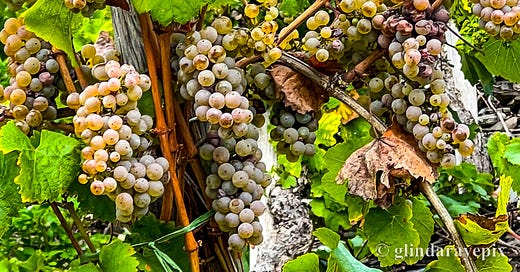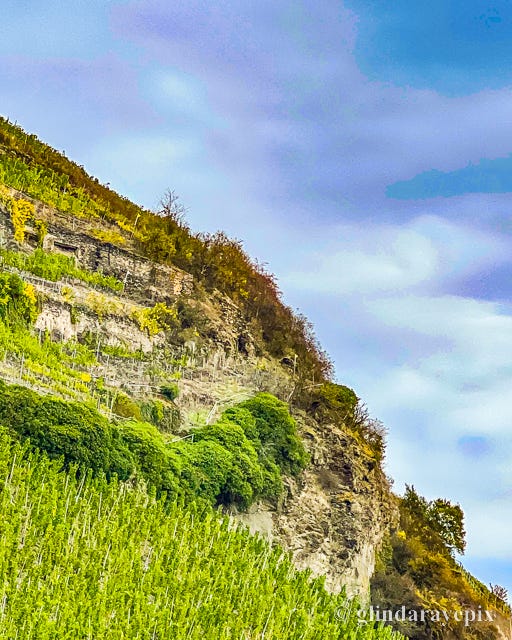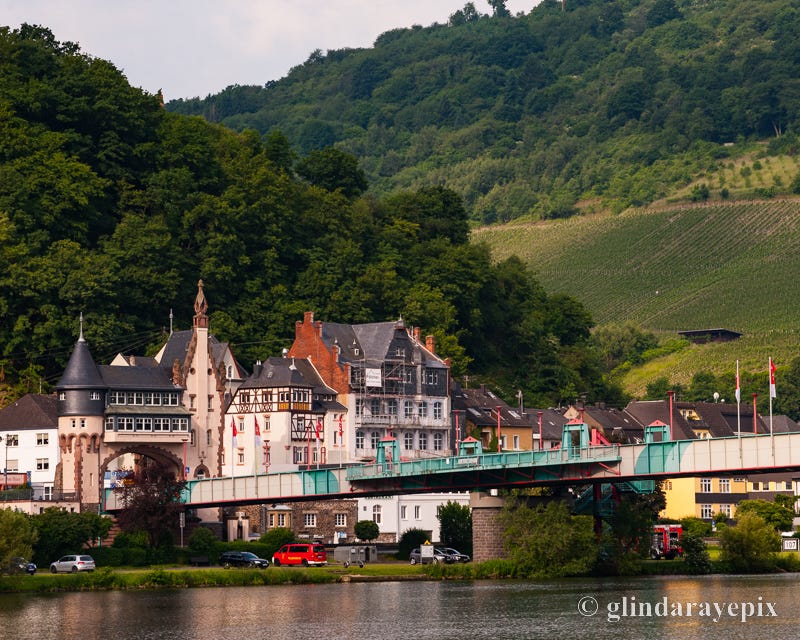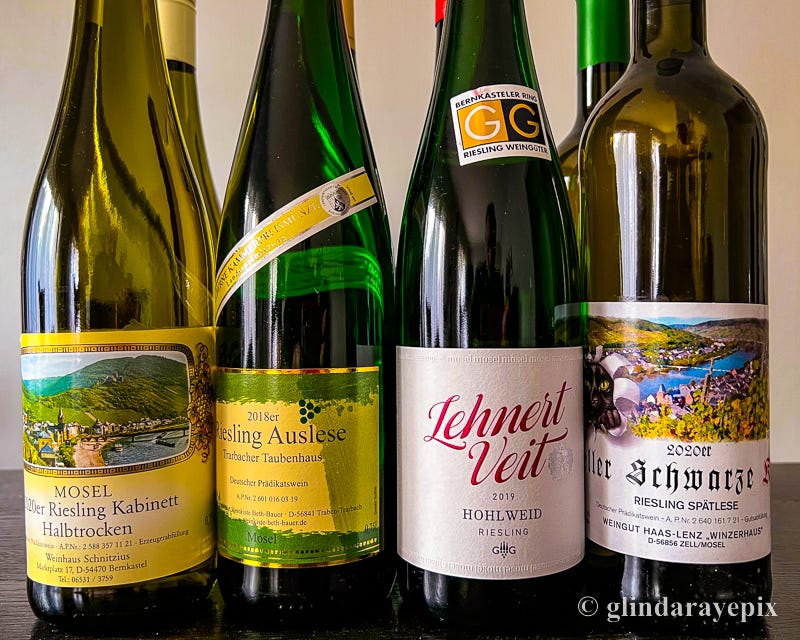Black Cats and Golden Droplets
Winding Along Through the Villages of the Mosel River
A gazillion years ago, in what’s called the Devonian Age, the Earth’s crust in Central Germany pushed upward and, through the idiosyncratic vagaries of erosion, carved out of the hardening plateau one of the most beautiful serpentine valleys on the planet. It would take a mechanical crow a few hours to fly the 128 Km straight from Trier to Koblenz on the German Mosel River. In a car, you’d need three and a half hours (with zero traffic) and enough gas and patience to move you the 218 Km from end to end. Or you could cycle it (ten hours), walk it (two days), or kayak it (?). A host of travelers, mainly native Germans, do every year.
Wine grapes didn’t just spontaneously erupt out of the steep, slate hills and brittle crags along the banks—like everywhere else in Europe, the Romans brought them. And then, when Trier became the center of North European culture, the Archbishop-Elector decreed the white Riesling grape as the fruit of choice. It was an odd selection, in that the Riesling is a finicky grape that requires hours of sunlight—but almost no soil—to even ripen. But that was exactly what the northern shore of the Mosel offered.
So as you drive along the gorgeous, unhurried river, you’ll find steep bank after steeper bank of photogenic grapes sunbathing in the afternoon glare. But climb out of the valley on a forested side lane into the Eifel (north) or Hunsrück (south) Mountains, and there is nary a grape to be found.
Ben’s father discovered the Mosel in 1964 on his way from Bruxelles to the steel mills of the Ruhr. In those days, you bought a great wine by the cask, then waited for the producer’s nephew to show up at your house anywhere in Europe with your barrel and his bottling equipment. The hills were too steep for machinery, so each bunch of grapes was picked—at some risk to the picker—by hand, then slid down the hillside in bright red, plastic boxes. Families combined into associations and sold their grapes and wines to the wine-makers and dealers you still meet today. No one got particularly rich, but everyone made a nice living, passing their stories and secrets from one generation to the next.
So what to make of all the strange German nomenclature you find on the label of a Mosel wine? First of all, the product is so inexpensive—it’s hard to spend more than $25 on a great dinner wine—that it makes no sense to skimp on quality. There are four main grades, and in a pinch (or a bar), we might settle for a Qualitätswein (second-best, with sugar added to boost the alcohol). But generally, it makes more sense to head straight for one of the great white wines of the world, the all-natural and tightly regulated Prädikatswein.
Once you get past this stage, the classification becomes a matter not of quality, but of the grape’s age at harvesting. Thus, you have the three drinking/dinner wines:
Kabinett—the standard, a very light, pale, and dry white.
Spätlese—picked later, a little sweeter, but still low in alcohol.
Auslese—late, sweet, a thick amber, and intense enough to hold up to a steak or a plate of Sauerbraten.
Later still, there are the three dessert wines, nearly indistinguishable from a syrup you might pour over vanilla ice cream:
Beerenauslese
Trockenbeerenauslese
Eiswein
From the Auslese onward, the picked grapes are so ripe that they include an increasing percentage of what is politely called “noble rot”. At the extreme, the Eiswein grapes are virtually raisins.
Of the three dinner wines, we usually go with a Spätlese and order it—very important—dry (Trocken) or medium-dry (Halbtrocken). That way, you get the high acidity, sweetness, and distinctive mineral notes that make a Mosel wine so unique and important.
For all its fame in European wine circles, the Mosel isn’t especially dedicated to the export trade. Less than 30% goes that way, so if you really want the full range of experience, you have to come here. Every other year when we do, we start half-way up-river in the Mittelmosel at Cochem, then wind our way back to Trier with four village stops along the way:
Cochem:
Cochem itself is no great shakes as a wine producer, but one of the prettiest towns in Germany and the fulcrum of the river’s commerce. Ben’s love affair with the area dates from his early teens, when Dad used to drop him off here every spring, paying Herr Müller in advance for room and board and a week’s worth of linguistic and cultural immersion. Nowadays, the crusty old innkeeper’s descendants all speak some kind of English—everyone in Germany does—but you hardly ever hear a word of it from the regulars who still mob the outrageous breakfast buffet.
Zell:
This is a classic working agricultural village and not the most picturesque place on earth—although they do try, with the usual festivals and fairs. But it is home to the world-famous Zeller Schwarze Katz (Black Cat). We always come away with a few bottles of the local enthusiast’s version.
Traben-Trarbach:
The twin villages of Traben and Trarbach straddle the river, with most of the wine dealers found along the tiny, intricate lanes on the Trarbach bank. Trarbach might be the most picturesque village in Germany, with vineyards inching down into the antique backyards and byways of the village itself. Traben, on the other hand, is all business.
Bernkastel-Kues:
Bernkastel is the sentimental beating heart of the region, with small, chic hotels and independent restaurants that serve some of the best German food found anywhere. When an eighty-something on his bike notices you checking out the menus and stops to tell you where to go and exactly what to order, do what he says. Just don’t forget your appetite, and add a bottle of Bernkasteler Riesling Kabinett Halbtrocken to round out the perfect meal.
Piesport:
Usually, by the time we reach Piesport, we’ve satisfied all of our principal German food preoccupations—Wienerschnitzel, Sauerbraten, Kartoffelknödel, Eintopf, Goulaschsuppe, and Erbsensuppe. But for 20 years, we’ve saved our love of Bratwurst mit Senf und Bratkartoffeln for the lawn above the river at our favorite Piesport dealer, with a bottle of his finest—and our all-time favorite white—Piesporter Goldtröpfchen. “Golden Droplets” doesn’t do justice to this wine.
After the catastrophes of the 20th century, much of Germany became the poster child for the dull and uniform Bauhaus and barracks style of modernity that was needed to quickly house and get the citizenry back onto its feet. Cochem sustained some damage in the bombing, but the Mosel as a whole pretty much sat out the worst of the war. Perhaps this explains the make-up of the average tourist you meet here—older, more nostalgic, and more German, favoring small, independent inns, local restaurants, and riverside campsites. One imagines that even the younger families come here because their parents and grandparents first brought them to this quiet, peaceful idyll. Either way, this stretch of the Mosel is that unusual traditional landscape that doesn’t feel like it’s about to be swallowed up in the canned soup of the modern age. And that’s a rare and wholesome bit of serendipity.














Sometimes(most of the time, really) I read your stories and learn new things.
This time I learned new things about a couple of my favorite things: Rieslings and Zeller Schwarze Katz